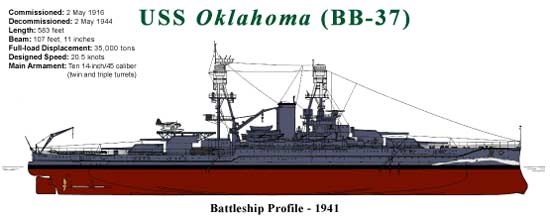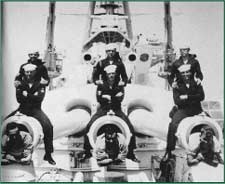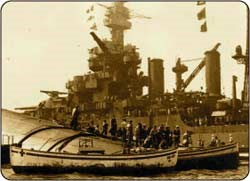Last updated: April 14, 2021
Thing to Do
Visit the USS Oklahoma Memorial


In May of 1916, the USS Oklahoma was the 37th battleship commissioned by the United States Navy. After her sea trials, she joined the Atlantic Fleet and saw duty on the Eastern Seaboard, where she protected convoys during World War I. In the years leading up to World War II, she cruised the Atlantic and Pacific Oceans as well as the Mediterranean Sea.
In October of 1936, the battleship was transferred to the Pacific Fleet. She operated for four years out of her homeport in San Pedro, California, before being moved to Pearl Harbor on December 6, 1940. Her last mooring took place on December 5, 1941, when she took her place with six other battlewagons in a location that would forever be known as "Battleship Row."


To the crew, she was affectionately know as "The Okie." A battleship was a small town gone to sea, her inhabitants mostly young and far from home.
USS Oklahoma survivor Stephen Bower Young, wrote: "Despite the passage of time, it seems like yesterday. My mind sees clearly the shipmates I knew so well as they emerged, laughing and talking from a hatch, portside, main deck, aft, of the Oklahoma. It is a time for morning quarters for muster, and at the urging of their petty officers, the white-uniformed sailors good-naturedly form into double ranks. They stand at ease, squaring round hats over suntanned faces. Their talk is animated and they turn in my direction. Then a cloud grows darker and I see those certain few less clearly."


The USS Oklahoma capsized at 8:08 A.M., approximately 12 minutes after the first torpedo hit. Hundreds of men were trapped below her decks. They found themselves in a bizarre world turned upside down, in pitch-black darkness, as compartments filled with water. Death came to 429 officers, sailors and Marines, marking the second greatest loss of life at Pearl Harbor.
But not all was lost. Some men waited in compartments for rescue, while others began thinking of ways to escape their watery tomb.

Of the 14 men trapped in D-57, three made a daring escape. They swam nearly 20 feet down the trunk space, 35 feet out of the hatch and across the upside down deck, and finally ascended almost 30 feet to the water's surface. Ordinary men with extraordinary courage swam approximately 90 feet to freedom.
The hours passed by slowly for those trapped below decks. Using hammers and wrenches, they pounded on bulkheads to draw attention to would-be rescuers. For those in compartment D-57, time was running out as the air grew foul and the water steadily rose.
Over the next two days, 32 men would be pulled from the hull of the USS Oklahoma. Eleven came from D-57, a storage compartment known as the "Lucky Bag."
In 1944, the Oklahoma was salvaged and raised at Pearl Harbor. Because new battleships of greater strength and size had been added to the fleet, she was denied future service and decommissioned. In 1947, she was sold for scrap but sank in a storm while being towed to the West Coast.
If you have a service animal that you would like to bring to the monument, please refer to the ADA service animal guidelines. You can also take a look at their Frequently Asked Questions.
Walking between facilities can be challenging for visitors with mobility issues, but there are several benches throughout the visitor center for rest opportunities.
There are no doctors or nurses on-site. EMS is available and a hospital is nearby. If you have a medical need please call 911.
